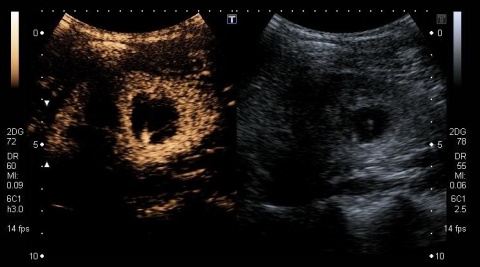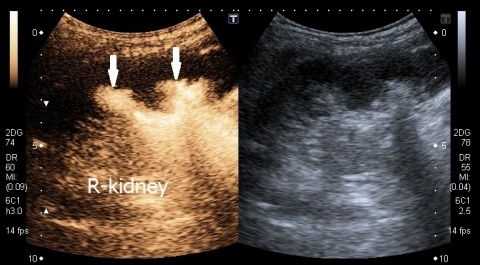Interview • Paediatric imaging
Ultrasound contrast agents are considered a medical drug
Paediatric imaging is a subspecialty that uses a diverse range of imaging systems, from classical X-ray to ultrasound, CT and MR.
Interview: Sascha Keutel

In an interview with Dr Damjana Ključevšek, consultant paediatric radiologist at the Children’s Hospital of the University Medical Centre of Ljubljana, Slovenia, spoke of the challenges and particularities in paediatric imaging, especially in the use of contrast-enhanced ultrasound in children.
Asked about the distinct aspects of child imaging, Dr Damjana Ključevšek explained: ‘Paediatric radiologists deal with different developmental stages from foetal life, through early childhood, to adolescence. As the quote goes, “Children are not small adults”. It’s very important to be familiar with their embryology, maturation and growth. Many different diseases occur at different ages, and children with the same disease require a different approach at different ages. The International day of Radiology 2015 was dedicated to paediatric radiology, which says a lot about the importance of this imaging subspecialty. In our country, paediatric imaging includes imaging of foetus, individuals younger than 18, and also young adults in the case of rare chronic diseases (e.g. some storage disease, unusual or very uncommon congenital disorders).’
How do procedures differ from adult imaging?

‘For a child, diagnostic imaging is stressful. He/she is put into an unknown environment, which is noisy, busy, and full of strange equipment. Therefore, the environment should be made as friendly as possible for children, and a sense of trust should be developed between the radiologist, radiographer, child and parents. It’s necessary to take some time and explain to the parents, why and how the radiographic procedure is going on. Parents are often actively involved in the procedure: they calm, comfort, and undress the baby, if necessary.
‘During imaging the child’s safety is of highest importance. The first task of the radiologist is to confirm whether the proposed examination is indicated or not, and if the examination answers specific clinical questions. According to the ALARA (as low as reasonably achievable) principle numerous devices for the child’s protection (lead protection, immobilisation ancillary equipment) and paediatric imaging protocols adapted to different ages and clinical questions are used.’
What affects contrast-enhanced ultrasound use in children?
‘First, ultrasound contrast agents (UCAs) in general are not registered for individuals younger than 18 years and their current use is off-label, which makes their application in children questionable, because of legal issues. In our hospital we gained approval from our National Medical Ethics Committee, which allows us to use UCA in children.
‘It’s of major importance to obtain written informed consent signed by parents or the legal child’s caretaker before CEUS, after a detailed explanation of the examination, procedure, clinical value, and the safety of UCAs. UCAs are not officially available in all countries. On the other hand, there is a need for diagnostic innovation and child-friendly imaging in daily clinical routine.’
Are there risks in using Contrast-enhanced ultrasound (CEUS) for children?

‘UCAs are considered a medical drug and there is always a potential risk for side effects. Therefore, the safety issue of UCAs’ in children is very important. The safety of UCAs, either intravenous or intravesical, has been evaluated in several studies. Intravenous application CEUS is less widespread, but is slowly gaining popularity among paediatric radiologists as a problem-solving method. Unfortunately, the procedure has not been standardised and there are no official recommendations regarding the dose of UCAs, which should be appropriately adjusted according to the patient’s weight or age, the examined organ, and to the probe.
‘Recently, a meta-analysis of adverse effects after intravenous application of second-generation UCAs was published by Piskunowicz. Only one severe anaphylactoid reaction in a child following the intravenous administration of UCAs has been described, so far.
‘In some children some minor transitional adverse reactions (urtica and rash, a brief alteration of taste sensation, mild tinnitus, light-headedness) were recorded. The European survey and meta-analysis of Darge et al. evaluated the intravesical use of UCAs in more than 7,000 children noticed only 0.8% transient adverse events, such as dysuria, haematuria, urinary retention, urinary tract infection, perianal irritation, abdominal or urethral discomfort etc. These are more likely related to bladder catheterisation than the UCAs. All these studies show high safety profile of UCAs administered either intravesically or intravenously.’
Are there established safety measures to protect children?

‘As mentioned, the first safety measure is the proper indication for CEUS. We also have to consider the described limitations or contraindications related to UCAs.
‘For intravesical application of UCA there is no need for extra safety measures. Due to the possibility of a potential anaphylactoid reaction, we are more cautious of UCAs during IV administration, the precautionary measures are the same as for other contrast agents and a possible anaphylactopid reaction and they are an integral part of the equipment in our examination rooms.’
Profile:
Consultant paediatric radiologist Damjana Ključevšek MD graduated from the Ljubljana medical faculty in 1989 and gained her PhD in 2009. Today, she is assistant professor of radiology for medical and postgraduate students at the University Medical Centre of Ljubljana Children’s Hospital. Ključevšek is also a member of the European Society of Paediatric Radiology and works as a European coordinator for paediatric radiology in Slovenia.
ECR 2016 - Don't miss
Friday 4 March 4:00–5:30 p.m., Room M3
Expanding horizons in paediatric imaging
03.03.2016











